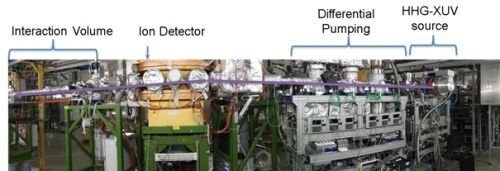XUV Spectroscopy of Molecules and Highly Charged Ions
Within this project we are employing High Harmonic (HHG) sources developed in our group (link zu HHG oder Quelle) to examine molecules and highly charged ions. Our light sources reach into the extreme ultraviolet (XUV) wavelength regime delivering high photon flux (>1011ph/s) at a very high repetition rate (~few MHz) and ultrashort pulse durations (few 10fs). These properties together with the table-top easy hands on, portable nature of the laser sources make it a versatile tool for spectroscopy experiments at ion storage rings. We can adapt our lab-type XUV source to meet the strict requirements (i.e. vacuum, automatization) typically present at such ion storage rings. The photon energy of the XUV photons is high enough to ionize targets provided by these ion sources. Furthermore when accelerated the energies of the optical transitions, such as for lasers, are boosted to the x-ray region. Thus, ionization of high charge states is feasible. The strong fields carried by heavy, highly-charged ions are their outstanding attributes for atomic and applied physics research. For the heaviest ions, Quantum ElectroDynamics (QED), the Standard Model of electromagnetism and a basis of modern physics, will be probed.
These experiments extend the knowledge of atomic structures, QED-effects in strongly bound electron systems, and precisely benchmark descriptive models.
Setup of a photoionization experiment at an ion storage ring. XUV photons are created at the right and travel leftwards along a vacuum system. A differential pumping stage connects both XUV laser and ion storage ring. XUV-Photoionization of target ions at the left will be detected in a dedicated ion detector which is placed in one the yellow bending magnets of the storage ring.
Picture: Univ. Jena, IAP-
References
[1] J. Rothhardt, M. Bilal, R. Beerwerth, A. Volotka, V. Hilbert, T. Stöhlker, S. Fritzsche, J. Limpert, "Lifetime measurements of ultra-short-lived excited states in Be-like ions," X-Ray Spectrom. 49, 165-168 (2020). link to journalExternal link
[2] V. Hilbert, M. Tschernajew, R. Klas, J. Limpert, J. Rothhardt, "A compact, turnkey, narrow-bandwidth, tunable, and high-photon-flux extreme ultraviolet source," AIP Advances 10, 045227 (2020). link to journalExternal link
[3] M. Tschernajew, P. Gierschke, H. Lin, V. Hilbert, J. Kurdal, A. Stancalie, J. Limpert, J. Rothhardt, "Differential Pumping Unit for Windowless Coupling of Laser Beams to Ultra High Vacuum", Vacuum accepted (2020)
